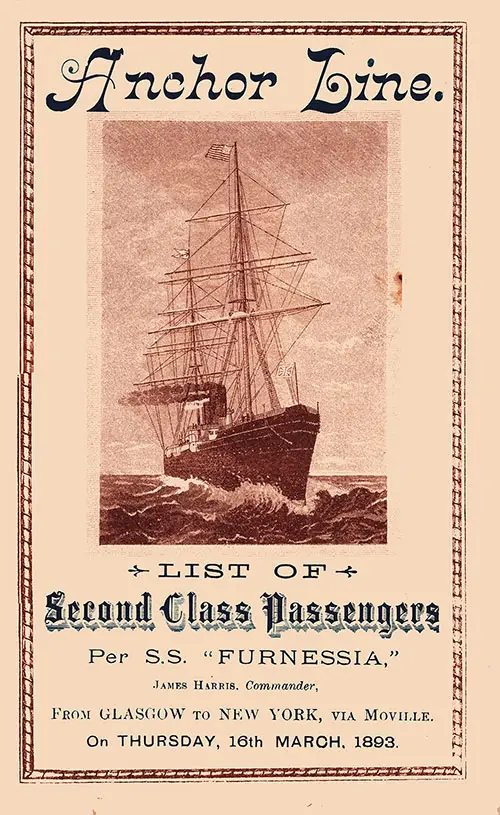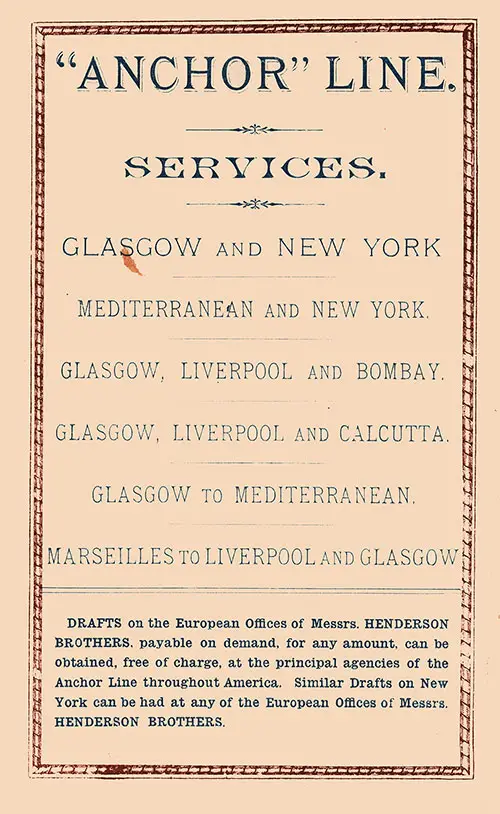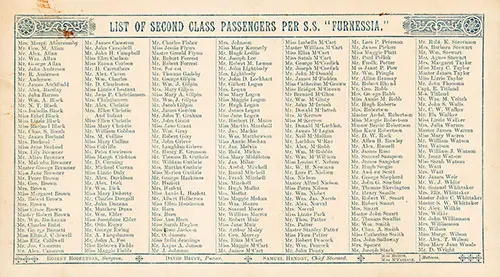Across the Atlantic in Comfort: The SS Furnessia Second Class Passenger List, 16 March 1893

Front Cover of a Second Class Passenger List from the SS Furnessia of the Anchor Steamship Line, Departing Thursday, 16 March 1893, from Glasgow to New York via Moville, Commanded by Captain James Harris. This image describes a poster for second-class passengers traveling aboard the S.S. "Furnessia." The Visual Elements Likely Include Aspects of Transport, Watercraft, and the Sailing Experience. A Well-Preserved Passenger List. | GGA Image ID # 1fc553c8be
🚢 Review & Summary — SS Furnessia Passenger List, 16 March 1893
Ship, Route, and Key Voyage Details
The SS Furnessia, operated by the Anchor Steamship Line, departed Thursday, 16 March 1893, from Glasgow, Scotland, bound for New York City via Moville, Ireland. This was a Second Class passenger manifest, reflecting the growing importance of middle-class transatlantic travel in the late 19th century.
Commanding the voyage was Captain James Harris, supported by an experienced senior staff including:
- Surgeon: Robert Robertson
- Purser: David Bruce
- Chief Steward: Samuel Hendry
- Matrons: Miss Brodie & Miss McFarlane
This sailing represented a well-timed seasonal crossing, just ahead of spring, often chosen by emigrants, students, clergy, and professionals seeking opportunities in North America.
The Ship: SS Furnessia
- Launched: 1880
- Operator: Anchor Line (Henderson Brothers, Glasgow)
- Tonnage: ~5,500 GRT
- Typical Route: Glasgow → Moville → New York
- Design: Built for both emigrant and cabin passenger traffic, but by the 1890s she had become popular for affordable second-class service.
- Notable Features: Twin-screw propulsion for stability, spacious second-class lounges, and an emphasis on meals and accommodations that rivaled many competitors’ first-class on smaller ships.
Senior Officers and Staff
- Commander: Captain James Harris
- Surgeon: Robert Robertson
- Purser: David Bruce
- Chief Steward: Samuel Hendry
- Matron: Miss Brodie
- Matron: Miss McFarlane
Second Class Passengers
- Mrs. Margaret. Abercromby
- Mr. Geo. M. Allan
- Mr. Alex. Allan
- Mr. Win. Allan
- Mr. George Allan
- Mr. John Anderson
- Mr. R. Anderson
- Mr. Anderson
- Mr. James Archibald
- Mr. Alex. Barclay
- Mr. John Barron
- Mr. Wm. A. Black
- Mr. N. T. Black
- Mrs. Isabella Black
- Miss Ethel Black
- Miss Lizzie Black
- Miss Rachael Black
- Mr. Chas. S. Booth
- Mr. James Borland
- Mrs. Borland
- Miss Jane Borland
- Mrs. Lily Bremmer
- Mr. Allan Bremmer
- Mr. Malcolm Bremmer
- Master George Bremmer
- Miss Jane Bremmer
- Mr. Peter Brown
- Mr. Geo. Brown
- Mrs. Brown
- Miss Margaret Brown
- Mr. Robert Brown
- Mrs. Brown
- Miss Grace Brown
- Master Robert Brown
- Mr. Wm. Buchanan
- Mr. Charles Buist
- Mr. George Burnett
- Miss Eliza J. Caldwell
- Miss Eliz. Caldwell
- Mr. Jas. Cameron
- Mr. Alex. Cameron
- Mr. James Cameron
- Mr. John Campbell
- Mr. John H. Campbell
- Miss Elen Carlson
- Miss Emma Carlson
- Mr. II. Carruthers
- Mr. Alex. Caven
- Mr. Win. Charles
- Mr. D. Charleston
- Miss Lizzie Chestnut
- Mr. Jens P. Christiansen
- Mrs. Christiansen
- Mr. Alex. Christie
- Mrs. Ellen Christie And Infant
- Miss Ellen Christie
- Miss Mary Christie
- Mr. William Cobban
- Mrs. M. Collins
- Miss Mary Collins
- Miss Colville
- Mr. Peter Cowieson
- Miss Margaret Crichton
- Mr. D. Cuming
- Mr. Michael Curran
- Miss Lizzie Daly
- Mr. Alex. Davidson
- Mr. Alex. Dick
- Mr. Wm. Dick
- Miss Mary Doherty
- Mr. Charles Dongall
- Mr. John Duncan
- Mr. Matthew Dunn
- Mr. Win. Elder
- Miss Josephine Elder
- Mr. Otto Enger
- Mr. George Ewing
- Mr. A. Farquharson
- Mr. John A. Fee
- Miss Rebecca Fields
- Miss Maggie Fields
- Mr. Charles Fisher
- Miss Jessie Flynn
- Master Gerald Flynn
- Mr. Robert Forrest
- Mr. Robert Forrest
- Mrs. Forrest
- Mr. Thomas Gadsby
- Mr. George Gilpin
- Mr. Win. J. Gilpin
- Mrs. Mary Gilpin
- Miss Mary A. Gilpin
- Mr. Win. J. Gilpin
- Mr. Jacob Gilpin
- Mr. James Gordon
- Mr. John T. Graham
- Mr. John Grant
- Miss Jane Grant
- Mr. Wm. Gray
- Mr. Robert Gray
- Mr. John Grieve
- Mr. Laughlan Grieve
- Mr. Henry K. Grunson
- Mr. Thomas B. Guthrie
- Mr. William Guthrie
- Mrs. Martha Guthrie
- Miss Marion Guthrie
- Mr. George Harkness
- Mr. Hazlett
- Mrs. Hazlett
- Miss Annie L. Hazlett
- Mr. Albert Hellstrom
- Miss Ellen Henderson
- Mr. Horn Mrs. Horn
- Miss Ann Horn
- Miss Sarah Hughes
- Miss Rose Jackson
- Mr. O. Jansen
- Miss Bella Jennings
- Mr. Kajus A. Jensen
- Mr. J. Johnson
- Mrs. Johnson
- Miss Mary Kennedy
- Mr. Hugh Ledlie
- Mr. Joseph Lee
- Mr. Robert M. Lemon
- Mr. John Lightbody
- Mrs. Light body
- Mr. John D. Lockhart
- Mr. Gilbert Logan
- Mrs. Logan
- Miss Mary Logan
- Miss Maggie Logan
- Mr. Hugh Logan
- Mr. James Logan
- Miss Jane Logan
- Mr. Herbert H. Mann
- Miss Martha Marshall
- Mr. Jas. Mathie
- Mr. Wm. Matthewson
- Miss Annie Meehan
- Mr. Jas. Melvin
- Mr. Robt. Michie
- Miss Mary Middleton
- Mr. Jas. Milne
- Mr. Arehd. Mitchell
- Mr. Ranal Mitchell
- Mr. Frank Mitchell
- Mrs. Mitchell
- Mr. Hugh Moffat
- Mrs. Moffat
- Miss Maggie Mohan
- Mr. Win. Monro
- Mr. Samuel Moore
- Mr. William Morrin
- Mr. Robert Muir
- Miss Jane Muir
- Mr. Arthur Muiry
- Mr. Geo. Murray
- Mrs. Eliza McCart
- Miss Maggie McCart
- Mr. James McCart
- Miss Isabella McCart
- Master William McCart
- Miss Eliza McCart
- Miss Sarah McCart
- Mr. George McCordick
- Mr. Joseph McCordick
- Mr. John McDonald
- Mr. James McFadden
- Miss Catherine McGeown
- Miss Bridget McGeown
- Mr. Bernard McGhee
- Mr. Win. McGinty
- Mr. John McIntosh
- Mr. Donald McIntosh
- Mrs. McKerrow
- Miss McKerrow
- Mr. Donald McLachlan
- Mr. James McLagan
- Mr. Neil McMullan
- Mr. Lachlan McRae
- Mr. Alex. McRobb
- Mr. Win. McRobbie
- Mr. Win. McWilliam
- Miss Louisa C. Nelson
- Mr. W. H. Newman
- Mr. Lars P. Nielson
- Mrs. Nielson
- Master Alfred Nielson
- Miss Petra Nilson
- Mr. Win. Nisbet
- Mr. M in. Jas. Norris
- Mr. Alex. Norval
- Mrs. Norval
- Miss Lizzie Park
- Mr. Thos. Patter
- Mrs. Patter
- Master Stanley Putter
- Miss Flora Patter
- Mr. Robert Peacock
- Mr. Win. Peacock
- Mr. John Peany
- Mr. Lars P. Peterson
- Mr. James Picken
- Miss Maggie Platt
- Mr. Paul Pollok
- Mr. Frederik Potter
- Miss Janet P. Pow
- Mr. Wm. Pringle
- Mr. Allan Ramsay
- Mr. Robert Rhynd
- Mr. Geo. Robb
- Mrs. George Robb
- Miss Annie M. Robb
- Mr. Hugh Roberts
- Mrs. Robertson
- Master Archd. Robertson
- Miss Maggie Robertson
- Master Bernie Robertson
- Miss Kaie Robertson
- Mr. D. W. Rock
- Mr. Allen H. Rowley
- Mr. Alex. Russell
- Mr. James Rust
- Mr. Samuel Sampson
- Mr. James Sangster
- Mr. Hugh Scogie
- Mr. Andrew Scott
- Mr. George Shepherd
- Mr. John G. Sindair
- Mr. Thomas Skevington
- Mr. Henry Smalls
- Mr. Robert W. Smart
- Mr. Robert Smart
- Mrs. Smart
- Master John Smart
- Mr. Thomas Smellie
- Mr. Win. Smith
- Mr. Chas. A. Smith
- Miss Catherine Smith
- Mrs. John Solloway
- Mrs. Spence
- Mr. Joseph Stark
- Mr. Robt. K. Stevenson
- Mrs. Barbara Stewart
- Mr. Wm. Stewart
- Mrs. Agnes Stewart
- Mrs. Margaret Taylor
- Miss Mary C. Taylor
- Master James Taylor
- Miss Lizzie Taylor
- Mr. John Thomson
- Capt. R. Titland
- Mrs. Titland
- Mr. Wm. M. Veitch
- Mr. John S. Walls
- Mr. C. W. Walker
- Mr. Eb. Walker
- Miss Lizzie Walker
- Mrs. Julia Warren
- Master James Warren
- Miss Mary Warren
- Mr. William Watson
- Mrs. Watson
- Mr. William J. Watson
- Mr. Isaac Watson
- Miss Sarah Watson
- Mr. Watt Mrs. Watt
- Mr. James Weir
- Mr. W. J. White
- Mr. Samuel Whittaker
- Mrs. Eliz. Whittaker
- Master John C. Whittaker
- Master S. W. Whittaker
- Mr. Alex. Wilkie
- Mrs. Wilkie
- Mr. John Williamson
- Mrs. Williamson
- Mr. Wilson
- Miss Margaret Wilson
- Mr. Alex. T. Wilson
- Miss Mary Jane Woods
- Mr. D. Wright
Notable Passengers & Historical Context
While this was largely a middle-class manifest, several passengers stand out for their professional or social prominence:
Maritime & Military
Capt. R. Titland — Likely a Norwegian or Scottish mariner traveling either for commercial shipping duties or family matters. His presence among second-class travelers may indicate a transfer to a vessel in New York or business within the maritime sector.
Religious Figures
Although no high-profile clergy dominate the list as in some saloon-class voyages, second-class travel frequently included missionaries, lay ministers, or theological students—especially on Anchor Line ships, which were popular with church-affiliated travelers.
Professionals & Skilled Workers
Several passengers, such as Mr. Charles A. Smith, Mr. Robert W. Smart, and Mr. Samuel Whittaker, likely represented the rising skilled artisan and merchant classes who could afford the more comfortable and spacious second-class accommodations.
The inclusion of Mr. Wm. J. Gilpin and family hints at small business owners relocating to or visiting America, as the Gilpin name is linked historically with merchant activity.
Family Migration & Transatlantic Links
Names like Mrs. Ellen Christie and Infant, the McCart family, and the Hazlett family suggest multi-generational travel or chain migration, in which relatives already in America sponsored others to join them.
The mix of Scottish, Irish, Scandinavian, and English surnames reflects Glasgow’s role as a transatlantic departure hub for multiple ethnic communities.
Notable International Passenger
Mr. Kajus A. Jensen — A name of possible Danish or Norwegian origin, illustrating the multi-national demographic of second-class transatlantic voyages.
A Note About Drafts
Drafts on the European Offices of Messrs. Henderson Brothers, Payable on Demand, for Any Amount, Can Be Obtained, Free of Charge, at the Principal Agencies of the Anchor Line Throughout America. Similar Drafts on New York Can Be Had at Any of the European Offices of Messrs. Henderson Brothers.
What Makes This Passenger List Engaging
Diversity of Backgrounds — From Scandinavian sailors to Irish agricultural workers, from Scottish craftsmen to English shopkeepers, the list is a living snapshot of the migration patterns of the 1890s.
Family Networks — Many group entries (same surnames traveling together) allow genealogists to trace familial relationships.
Ethnic Clues — Passenger surnames offer valuable insight for historians researching settlement patterns in American cities like New York, Philadelphia, and Chicago.
Noteworthy Images 📸
Front Cover Artwork — An elegant lithograph capturing the Furnessia in profile, with visual nods to transatlantic travel and possibly New York Harbor.
List of Second Class Passengers — Provides a clear, well-preserved roll call, aiding in genealogical transcription.
Anchor Steamship Line Services Page — Outlines agency locations, ticketing procedures, and other services, offering historians a direct view of 19th-century passenger logistics.
Relevance for Teachers, Students, Historians, and Genealogists
For Teachers: This manifest can serve as a primary source for lessons on immigration, industrial-era transportation, and the socio-economic spectrum of late Victorian travelers.
For Students: Offers a tangible link between classroom immigration narratives and real individuals who made the journey.
For Genealogists: Provides critical departure and arrival data to connect with U.S. arrival records, naturalization documents, and census entries.
For Historians: Highlights the role of second-class travel as a bridge between elite saloon passengers and crowded steerage emigrants.
Final Thoughts – Why This Passenger List Matters ✨
The SS Furnessia’s 16 March 1893 sailing captures the transitional nature of transatlantic migration at the close of the 19th century. No longer exclusively the domain of the wealthy or the desperately poor, ships like the Furnessia facilitated the growth of an educated, mobile middle class crossing oceans for opportunity, education, or business.
This passenger list stands as a valuable historical record—not only for tracking individual journeys but also for understanding the broader cultural and economic forces shaping migration during the period.

Anchor Steamship Line Services. SS Furnessia Second Class Passenger List, 16 March 1893. | GGA Image ID # 1fc578cecd
List of Second Class Passengers, SS Furnessia voyage of 16 March 1893. | GGA Image ID # 22b529fea7. Click to View a Larger Image.
Purpose and Duties of a Matron on a Steamship in 1893
A Matron on a steamship in 1893 would have been responsible for a variety of duties to ensure the well-being and comfort of passengers, particularly women and children, during the often arduous transatlantic voyage. Her role would vary depending on the class of travel (steerage, second class, or first class) but generally included the following:
1. Supervising the Welfare of Female Passengers
- In Steerage: The Matron’s primary responsibility was to oversee and care for unaccompanied women, young girls, and families traveling in the steerage section. She ensured that proper behavior was maintained and that vulnerable women were protected from potential harassment or inappropriate behavior.
- In Second or First Class: While less common, a Matron in higher classes might assist women who were traveling alone or required additional help, such as elderly or infirm passengers.
2. Caring for Children
- The Matron often acted as a caretaker for children traveling without parents or those whose parents were overwhelmed or ill. She might supervise group play, ensure they were fed properly, and watch over their safety during the voyage.
3. Assisting with Medical Needs
- The Matron worked alongside the ship’s surgeon to care for sick passengers. This could include distributing medicine, ensuring passengers followed medical advice, and offering basic first aid. In steerage, where conditions were often overcrowded and unsanitary, the Matron’s role in monitoring hygiene and preventing the spread of illness was critical.
4. Monitoring Hygiene and Cleanliness
- In steerage, the Matron would ensure that the passengers maintained personal hygiene and that living areas were kept as clean as possible. This might involve inspecting the berths and common areas and encouraging passengers to use facilities like communal washrooms and fresh air on deck.
5. Distributing Meals
- In lower classes, the Matron might help with meal distribution, ensuring that women and children received food and that the process was orderly. She might also assist passengers in understanding how to access meals or adhere to shipboard schedules.
6. Providing Moral Guidance and Support
- The Matron acted as a moral authority, especially in steerage. She helped maintain decorum and often provided emotional support to passengers who were homesick, frightened, or uncertain about their future.
7. Handling Documentation and Immigration Preparation
- She might assist female passengers with their documents or provide guidance on immigration procedures to prepare them for inspections at the port of arrival, such as Ellis Island or Québec. This included ensuring that passengers had their belongings and paperwork ready for disembarkation.
8. Maintaining Order During Emergencies
- In case of emergencies, such as rough seas, illness outbreaks, or shipboard accidents, the Matron would help calm and organize women and children, ensuring they followed safety protocols and stayed in designated areas.
Skills and Qualities of a Matron:
- Firm yet Compassionate Leadership: The Matron needed to maintain order while being approachable.
- Good Communication: She often dealt with passengers from diverse cultural and linguistic backgrounds.
- Practical Knowledge: Basic medical training and knowledge of sanitation and hygiene practices were essential.
Importance of the Role:
The Matron’s presence was particularly vital in steerage, where conditions could be harsh and overwhelming for passengers. By focusing on the welfare of women and children, the Matron ensured that passengers were safer, healthier, and better prepared for the challenges they might face after their journey.
📜 Research note: Some names and captions were typed from originals and may reflect period spellings or minor typographical variations. When searching, try alternate spellings and cross-check with related records. ⚓
Curator’s Note
For over 25 years, I've been dedicated to a unique mission: tracking down, curating, preserving, scanning, and transcribing historical materials. These materials, carefully researched, organized, and enriched with context, live on here at the GG Archives. Each passenger list isn't just posted — it's a testament to our commitment to helping you see the people and stories behind the names.
It hasn't always been easy. In the early years, I wasn't sure the site would survive, and I often paid the hosting bills out of my own pocket. But I never built this site for the money — I built it because I love history and believe it's worth preserving. It's a labor of love that I've dedicated myself to, and I'm committed to keeping it going.
If you've found something here that helped your research, sparked a family story, or just made you smile, I'd love to hear about it. Your experiences and stories are the real reward for me. And if you'd like to help keep this labor of love going, there's a "Contribute to the Website" link tucked away on our About page.
📜 History is worth keeping. Thanks for visiting and keeping it alive with me.

